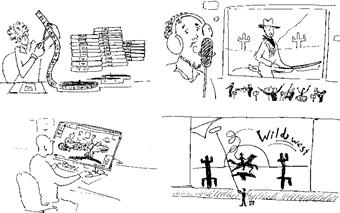Exercise 22. Match the words to make collocations
III. PRODUCTION STAGE
1. reach A. lot
2. develop the shooting script B. from scratch
3. recruit C. of several people
4. suit D. with other crew members
5. collaborate E. more crew
6. sequence F. the shooting stage
7. determine G. a camera
8. consist H. stage
9. operate I. daily rushes
10. attend J. of shots
11. sound K. budget
12. back L. into a cross plot
13. conduct M. the position of the camera
14. low / big N. clapboard
15. create O. to the actors’ appearance
16. view P. a recce
Q. various responsibilities
Exercise 23. Read the text below. Find passive structures and learn the words and word
Combinations in bold.
IV. Post-Production
All of this planning and filming leads up to the most vital aspect of film making — post production work. This turns individual scenes, called raw footage, into a finished motion picture. Editors select shots, combine them into sequences and splice together into a coherent storyline according to the script. There are several editing stages. While watching and discussing dailies with the director, the editor assembles the first copy, which is called editor’s cut, or rough cut. At the post-production stage the director and editor work on it together to make the director’s cut. The final cut can be supervised by producers who represent the film studio.
Composers add background music to create dramatic or comical effects. Special effects teams add computer-generated imagery and backgrounds to enhance the set or provide an as-yet-unseen character.
Post-production may also involve fixing mistakes not corrected during on set recordings. Quite often an actor’s microphone will not pick up crucial bits of dialogue or another microphone may pick up extraneous noises. During post- production, an actor may have to return to a sound booth in order to re-record lost dialogue or improve the original quality. This is called looping, automated dialogue replacement (ADR), orpost-synchronization (post-sync). Another function of this time is to add incidental sounds not captured during the original scenes. A specialist called a foley artist will record such sounds as an actor’s footsteps, a creaking door or gunshots. The sound designer is responsible for the final sound mix. He creates a blended soundtrack that incorporates dialogue, sound effects, and music.
Many directors and producers rely heavily on the ability of post-production teams to create a marketable film. Since principal shooting can be a hectic time for both actors and directors, some footage may prove to be unusable during the editing process. A film’s original ending may also be unpopular with test audiences. This could lead to reshoots before a final film is produced.
Other responsibilities during post-production may include publicity tours, promotional posters, contracts with distributors and the creation of auxiliary formats such as DVDs and soundtrack albums.

raw footage – несмонтированный отснятый материал
splice – склеивать, соединять
coherent – связный, логически последовательный
assemble – монтировать начерно
editor’s cut / rough cut – рабочая копия, первая сборка, черновой монтаж
director’s cut – режиссёрский монтаж
final cut – окончательный монтаж
computer-generated imagery (CGI) – компьютерная графика
to enhance – усиливать, улучшать
on set recording – запись во время съёмок
sound booth – аппаратная звукозаписи
looping/automated dialogue replacement(ADR)/post-synchronization (post-sync) – озвучание
automated dialogue replacement – автоматизированная замена диалогов (Am) =
post-synchronization (Br) – речевое озвучание
looping –закольцовка, запись реплик
incidental – сопровождающий
foley artist – специалист по записи шумов, звукооформитель, “шумовик”
